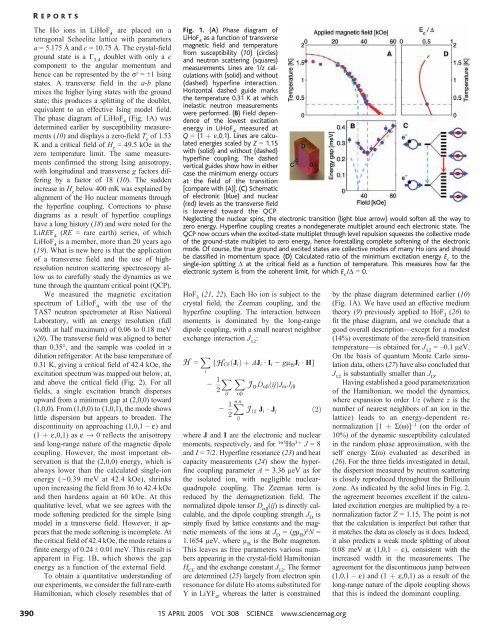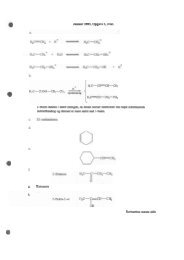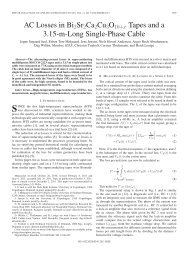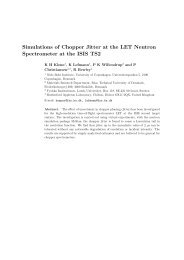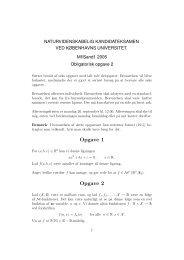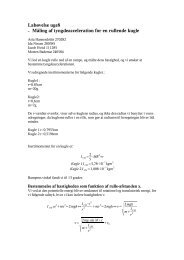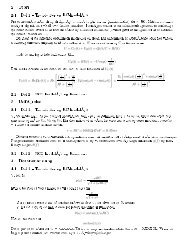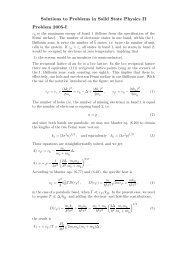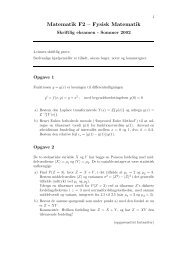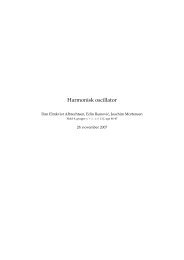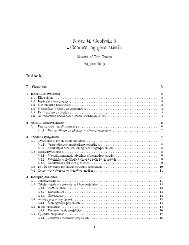Quantum Phase Transition of a Magnet in a Spin Bath
Quantum Phase Transition of a Magnet in a Spin Bath
Quantum Phase Transition of a Magnet in a Spin Bath
Create successful ePaper yourself
Turn your PDF publications into a flip-book with our unique Google optimized e-Paper software.
R EPORTSThe Ho ions <strong>in</strong> LiHoF 4are placed on atetragonal Scheelite lattice with parametersa 0 5.175 ) and c 0 10.75 ). The crystal-fieldground state is a G 3,4doublet with only a ccomponent to the angular momentum andhence can be represented by the s z 0T1Is<strong>in</strong>gstates. A transverse field <strong>in</strong> the a-b planemixes the higher ly<strong>in</strong>g states with the groundstate; this produces a splitt<strong>in</strong>g <strong>of</strong> the doublet,equivalent to an effective Is<strong>in</strong>g model field.The phase diagram <strong>of</strong> LiHoF 4(Fig. 1A) wasdeterm<strong>in</strong>ed earlier by susceptibility measurements(10) and displays a zero-field T c<strong>of</strong> 1.53K and a critical field <strong>of</strong> H c0 49.5 kOe <strong>in</strong> thezero temperature limit. The same measurementsconfirmed the strong Is<strong>in</strong>g anisotropy,with longitud<strong>in</strong>al and transverse g factors differ<strong>in</strong>gby a factor <strong>of</strong> 18 (10). The sudden<strong>in</strong>crease <strong>in</strong> H cbelow 400 mK was expla<strong>in</strong>ed byalignment <strong>of</strong> the Ho nuclear moments throughthe hyperf<strong>in</strong>e coupl<strong>in</strong>g. Corrections to phasediagrams as a result <strong>of</strong> hyperf<strong>in</strong>e coupl<strong>in</strong>gshave a long history (18) and were noted for theLiREF 4(RE 0 rare earth) series, <strong>of</strong> whichLiHoF 4is a member, more than 20 years ago(19). What is new here is that the application<strong>of</strong> a transverse field and the use <strong>of</strong> highresolutionneutron scatter<strong>in</strong>g spectroscopy allowus to carefully study the dynamics as wetune through the quantum critical po<strong>in</strong>t (QCP).We measured the magnetic excitationspectrum <strong>of</strong> LiHoF 4with the use <strong>of</strong> theTAS7 neutron spectrometer at RisL NationalLaboratory, with an energy resolution (fullwidthathalfmaximum)<strong>of</strong>0.06to0.18meV(20). The transverse field was aligned to betterthan 0.35-, and the sample was cooled <strong>in</strong> adilution refrigerator. At the base temperature <strong>of</strong>0.31 K, giv<strong>in</strong>g a critical field <strong>of</strong> 42.4 kOe, theexcitation spectrum was mapped out below, at,and above the critical field (Fig. 2). For allfields, a s<strong>in</strong>gle excitation branch dispersesupward from a m<strong>in</strong>imum gap at (2,0,0) toward(1,0,0). From (1,0,0) to (1,0,1), the mode showslittle dispersion but appears to broaden. Thediscont<strong>in</strong>uity on approach<strong>in</strong>g (1,0,1 – e) and(1 þ e,0,1) as e Y 0 reflects the anisotropyand long-range nature <strong>of</strong> the magnetic dipolecoupl<strong>in</strong>g. However, the most important observationis that the (2,0,0) energy, which isalways lower than the calculated s<strong>in</strong>gle-ionenergy (È0.39 meV at 42.4 kOe), shr<strong>in</strong>ksupon <strong>in</strong>creas<strong>in</strong>g the field from 36 to 42.4 kOeandthenhardensaga<strong>in</strong>at60kOe.Atthisqualitative level, what we see agrees with themode s<strong>of</strong>ten<strong>in</strong>g predicted for the simple Is<strong>in</strong>gmodel <strong>in</strong> a transverse field. However, it appearsthat the mode s<strong>of</strong>ten<strong>in</strong>g is <strong>in</strong>complete. Atthe critical field <strong>of</strong> 42.4 kOe, the mode reta<strong>in</strong>s af<strong>in</strong>ite energy <strong>of</strong> 0.24 T 0.01 meV. This result isapparent <strong>in</strong> Fig. 1B, which shows the gapenergy as a function <strong>of</strong> the external field.To obta<strong>in</strong> a quantitative understand<strong>in</strong>g <strong>of</strong>our experiments, we consider the full rare-earthHamiltonian, which closely resembles that <strong>of</strong>Fig. 1. (A) <strong>Phase</strong> diagram <strong>of</strong>LiHoF 4as a function <strong>of</strong> transversemagnetic field and temperaturefrom susceptibility (10) (circles)and neutron scatter<strong>in</strong>g (squares)measurements. L<strong>in</strong>es are 1/z calculationswith (solid) and without(dashed) hyperf<strong>in</strong>e <strong>in</strong>teraction.Horizontal dashed guide marksthe temperature 0.31 K at which<strong>in</strong>elastic neutron measurementswere performed. (B) Field dependence<strong>of</strong> the lowest excitationenergy <strong>in</strong> LiHoF 4measured atQ 0 (1 þ e,0,1). L<strong>in</strong>es are calculatedenergies scaled by Z 0 1.15with (solid) and without (dashed)hyperf<strong>in</strong>e coupl<strong>in</strong>g. The dashedvertical guides show how <strong>in</strong> eithercase the m<strong>in</strong>imum energy occursat the field <strong>of</strong> the transition[compare with (A)]. (C) Schematic<strong>of</strong> electronic (blue) and nuclear(red) levels as the transverse fieldis lowered toward the QCP.Neglect<strong>in</strong>g the nuclear sp<strong>in</strong>s, the electronic transition (light blue arrow) would s<strong>of</strong>ten all the way tozero energy. Hyperf<strong>in</strong>e coupl<strong>in</strong>g creates a nondegenerate multiplet around each electronic state. TheQCP now occurs when the excited-state multiplet through level repulsion squeezes the collective mode<strong>of</strong> the ground-state multiplet to zero energy, hence forestall<strong>in</strong>g complete s<strong>of</strong>ten<strong>in</strong>g <strong>of</strong> the electronicmode. Of course, the true ground and excited states are collective modes <strong>of</strong> many Ho ions and shouldbe classified <strong>in</strong> momentum space. (D) Calculated ratio <strong>of</strong> the m<strong>in</strong>imum excitation energy E cto thes<strong>in</strong>gle-ion splitt<strong>in</strong>g D at the critical field as a function <strong>of</strong> temperature. This measures how far theelectronic system is from the coherent limit, for which E c/D 0 0.HoF 3(21, 22). Each Ho ion is subject to thecrystal field, the Zeeman coupl<strong>in</strong>g, and thehyperf<strong>in</strong>e coupl<strong>in</strong>g. The <strong>in</strong>teraction betweenmoments is dom<strong>in</strong>ated by the long-rangedipole coupl<strong>in</strong>g, with a small nearest neighborexchange <strong>in</strong>teraction J 12:H 0 X EH CFðJ i ÞþAJ i I I i j gm B J i I H^ij 1 X XJ2D D ab ðijÞJ ia J jbijj 1 2abX n:n:ijJ 12 J i I J jð2Þwhere J and I are the electronic and nuclearmoments, respectively, and for 165 Ho 3þ J 0 8and I 0 7/2. Hyperf<strong>in</strong>e resonance (23)andheatcapacity measurements (24) show the hyperf<strong>in</strong>ecoupl<strong>in</strong>g parameter A 0 3.36 meV as forthe isolated ion, with negligible nuclearquadrupolecoupl<strong>in</strong>g. The Zeeman term isreduced by the demagnetization field. Thenormalized dipole tensor D ab(ij) is directly calculable,and the dipole coupl<strong>in</strong>g strength J Dissimply fixed by lattice constants and the magneticmoments <strong>of</strong> the ions at J D0 (gm B) 2 N 01.1654 meV, where m Bis the Bohr magneton.This leaves as free parameters various numbersappear<strong>in</strong>g <strong>in</strong> the crystal-field HamiltonianH CFand the exchange constant J 12. The formerare determ<strong>in</strong>ed (25) largely from electron sp<strong>in</strong>resonance for dilute Ho atoms substituted forY<strong>in</strong>LiYF 4, whereas the latter is constra<strong>in</strong>edby the phase diagram determ<strong>in</strong>ed earlier (10)(Fig. 1A). We have used an effective mediumtheory (9) previously applied to HoF 3(26) t<strong>of</strong>it the phase diagram, and we conclude that agood overall description—except for a modest(14%) overestimate <strong>of</strong> the zero-field transitiontemperature—is obta<strong>in</strong>ed for J 120 –0.1 meV.On the basis <strong>of</strong> quantum Monte Carlo simulationdata, others (27) have also concluded thatJ 12is substantially smaller than J D.Hav<strong>in</strong>g established a good parameterization<strong>of</strong> the Hamiltonian, we model the dynamics,where expansion to order 1/z (where z is thenumber <strong>of</strong> nearest neighbors <strong>of</strong> an ion <strong>in</strong> thelattice) leads to an energy-dependent renormalizationE1 þ S(w)^–1 (on the order <strong>of</strong>10%) <strong>of</strong> the dynamic susceptibility calculated<strong>in</strong> the random phase approximation, with theself energy S(w) evaluated as described <strong>in</strong>(26). For the three fields <strong>in</strong>vestigated <strong>in</strong> detail,the dispersion measured by neutron scatter<strong>in</strong>gis closely reproduced throughout the Brillou<strong>in</strong>zone. As <strong>in</strong>dicated by the solid l<strong>in</strong>es <strong>in</strong> Fig. 2,the agreement becomes excellent if the calculatedexcitation energies are multiplied by a renormalizationfactor Z 0 1.15. The po<strong>in</strong>t is notthat the calculation is imperfect but rather thatit matches the data as closely as it does. Indeed,it also predicts a weak mode splitt<strong>in</strong>g <strong>of</strong> about0.08 meV at (1,0,1 – e), consistent with the<strong>in</strong>creased width <strong>in</strong> the measurements. Theagreement for the discont<strong>in</strong>uous jump between(1,0,1 – e) and(1þ e,0,1) as a result <strong>of</strong> thelong-range nature <strong>of</strong> the dipole coupl<strong>in</strong>g showsthat this is <strong>in</strong>deed the dom<strong>in</strong>ant coupl<strong>in</strong>g.39015 APRIL 2005 VOL 308 SCIENCE www.sciencemag.org


